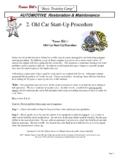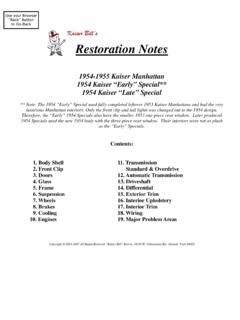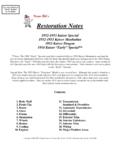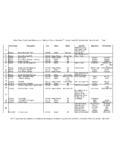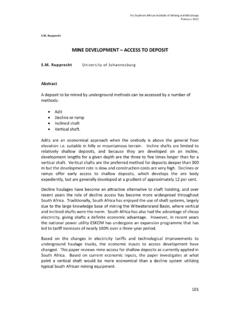Transcription of intake - kaiserbill
1 TROUBLE SHOOTING AND SERVICEINTRODUCTIONThe McCulloch Supercharger, ModelVS-57 (-A, -B, -C) is a single stage, centrifugal-type supercharger designed for use with automotive, stationary, or marine internalcombustion take-off is from the engine crankshaft through a single,cog-type vee belt. A variable-ratio input pulley on the supercharger provides for botha * low blower and high blower range of operation. Normally, when the engineis cruising (operating under minimum load requirements), the supercharger is beingdriven in the low blower range. When demand is made for power, the superchargercontrol system causes the pulley to be shifted into the high blower lubrication system is completely self-contained, eliminating connections to theengine lubricating system.
2 An internal oil sump holds eight ounces of lubricant, Type A automatic transmission fluid (AQ-ATF quality). A piston-type oil pump, actuatedby a cam ground into the input shaft, provides pressure lubrication of the internalmoving parts. A dip-stick oil gauge inserts in the oil filler tube located in the bearinghousing of the planetary drive system, incorporated between the input and output shafts, serves asa speed increaser for the the system is a ball bearing, friction-type,the use of noise producing gears is ball races serve toautomatically take up any wear that might develop in the Model VS-57 supercharger has been designed for installation before the car-buretor in the overall carburetion system. Under no circumstances should the super-charger be installed between the carburetor and the intake MOTORS CORPORATION6101 West Century BoulevardLos Angeles 45, California1 MECHANICAL OPERATION1.
3 GENERALAs with all centrifugal-type ; it is necessary to drive the impeller at avery high rpm rate to obtain boost pressure is accomplished in theMcCulloch Supercharger, Model VS-57 (.-A, -B,-C),by incorporating two speed in-creasers in the drive first increaser is the variable-ratio input pulley,which is keyed to the input shaft. The second increaser, which operates at a constantrate, is the planetary drive system between the input and output a ?-l/2 inch diameter crankshaft pulIey is used, the variable-ratio pulley offersa : 1 rpm increase in the fully closed the pulley is fully opened,the rpm increase is : 1. When the pulley flanges are fully closed, the super-charger is operating in the low blower the flanges are.
4 Fully separated,the supercharger is being driven in high blower range and maximum boost pres-sure output is being variable-ratio action of the input pulley is accomplished by the use of a sliding,rear pulley (The front pulley flange is keyed to the input shaft through asplined hub.) The rear flange is fitted with a splined bushing, that rides the inputshaft splined hub, and is coupled to its actuating air piston through a thrust-type ballbearing. Movement (or shifting) of the rear flange is automatically controlled by thesupercharger control control system serves to both initiate the shifting cycle and regulate the boostpressure output of the main component of the system is the sole-noid regulator, located in the bearing housing of the supercharger. The regulator isa solenoid operated valve that controls the passage of boost pressure, taken fromthedischarge throat of the carburetor, into an air chamber.
5 Within the chamber is anair piston which is coupled to the rear, or sliding flange of the supercharger solenoid can be energized in one of .several full automatic operationof the supercharger, it is recommended that a vacuum switch be used to closethesolenoid regulator circuit.(A vacuum switch is one in which the opening and closingof the contact points is controlled by the degree of vacuum present in the engine intakemanifold. ) DRIVE SYSTEMThe drive system of the McCulloch Supercharger, Model VS-57, as shown in Figure 1,is composed of the following,component input pulleyb. Input drive systemd. Output fixed flange (A-l) of the variable-ratio input pulley (A) is keyed to the input shaft(B) through a splined sliding flange (A-2) of the pulley is fitted with a splinedbushing to permit constant drive of the input shaft through the full limit of travel ofthe flange.
6 Movement of the flange is controlled by an air piston (ref.) working in anair chamber, or pulley is shown in its maximum ratio ball driver, (C) assembled to the input shaft, serves to rotate the drive balls (D)of the planetary system around the inner faces of the outer ball-races (E).The clutchdiscs (F) prevent the-outer ball-races from turning in their respective Drive Pulley-. Figure 13* .. the drive balls (D) revolve around the fixed cage formed by the two outer races,(E), they also rotate around their individual axis, as shown in Figure 2. This lattermotion is transmitted directly to the output shaft, (G), causing it to rotate. As theoutput shaft serves as the inner race of the planetary system, the system ratio, 1 : ,is calculated between the inner diameter of the ball races and the raceway of the out-put Race (stationary)Figure 2 III.
7 VARIABLE RATIO INPUT PULLEYThe variable ratio input pulley acts as a speed increaser (in shaft rpm) between thecrankshaft pulley and the supercharger. Normally, during cruising operation (minimumload requirements), the pulley flanges will be closed and the drive belt will be at theextreme outside edge of the full throttle acceleration or demand for power,. the pulley will open and the drivebelt will move to the bottom of the pulley, thereby increasing the input shaft of the variable ratio input pulley is a result of the corn bined functions of thecontrol system, solenoid regulator and the belt-tensioning arm and idler the supercharger shifts from high blower to low blower ; it is aresult ofboost pressure (taken from the supercharger discharge throat) being passed into theair chamber, behind the air pressure drives the piston forward and themovement is transmitted to the sliding flange of the pulley assembly through athrust-type ball pressure is sufficient to overcome.
8 The tension applied to thedrive belt by the belt-tensioning arm and, as the pulley flanges close, the belt isforced to the top of the pulley. An equalizer spring behind the piston helps to over-come the effect of the tensioning arm against the drive idle speed engine operation, the drive belt and vari-able-ratio pulley are in the high blower position. This isbecause the developed boost pressure is insufficient to over-ride the tension exerted against the drive belt by the belt-tensioning the shift cycle from low blower to high blower , a valve in the controlsystem closes to prevent boost pressure from entering the air chamber. The pres-sure within the chamber bleeds off and the tension on the drive belt (exerted by thebelt-tensioning arm) causes the belt to pull down into the pulley and separate the time required for either phase of the shifting cycle is approximately one belt-tensioning arm is generally mounted on the same bracket used to mount spring-loaded arm is geometrically located with relation to thecenter line of the supercharger input shaft.
9 The existing design should not be alteredin any way as such alteration will affect the shifting cycle of the variable -ratio CONTROL SYSTEMThe control system of the Model VS-57 supercharger serves to both initiate the shiftingcycles of the unit and to regulate the boost output pressure. This is accomplished bycontrolling the movement of the sliding flange of the input pulley to either increaseor decrease the effective working diameter of the pulley. The design makes possiblethree phases of supercharger operation, as follows:Phase A - Cruise Range, or Low BlowerPhase B - Power Demand, or High BlowerPhase C - Regulation (regulated high blower)In effect, the control system is an electrically operated valve which controls the of boost pressure from the discharge throat into the.
10 Air main electrical component of the system is the solenoid regulator, which is en-ergized by the closing of an external switch. Located in the bearing housing, the reg-ulator intersects an air passageway leading between the discharge throat and the airchamber containing the air piston. The external switch can be either a vacuum switch,operated off the intake manifold; or a kick-down type switch operated by depressingthe accelerator three phases of supercharger operation, as shown in Figure 3, are:Phase AThe solenoid regulator is not energized and the valve is open, permitting boost pres-sure to enter the air chamber. The air piston is driven forward, closing the variable-ratio pulley, and the supercharger is operating in low blower . Minimum horse-power is required to drive the supercharger during this phase, as the superchargeris not producing high level phase extends across the cruising range ofthe engine, where the engine does not demand, and cannot use, boost pressure.
